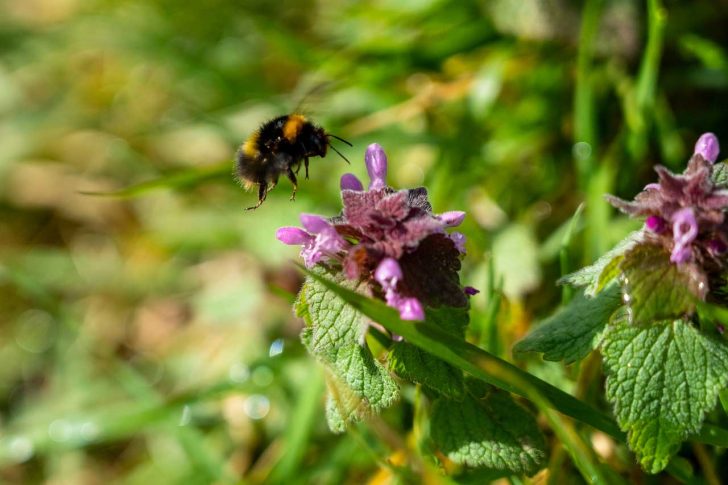Nourishing nature: small ways we can make a difference as the days draw in
Make cosy hedgehog homes, re-wild your communities and get planting: our top tips for regenerating nature close to home as the shadows lengthen and the colder weather arrives.
Take some time to see what you can do to support our wildlife in your corner of the countryside – and feel nourished by nature at the same time.
Food and drink for wildlife
Different animals prepare in different ways for autumn and winter. Some keep eating all year-round, others gather and store food for consumption over the winter. Here are some of the things you can do to help sustain local wildlife this autumn:
- If you’ve got the space, why not set up a bird feeder? Some garden birds remain active during the cooler months and will benefit from nuts and seeds high in energy and fat. Think starlings, blue tits, robins and sparrows. Depending on your local bird population, you may need to put food out twice a day – but you’ll be giving our feathered friends a helping hand and a better chance of surviving the cooler and frosty nights.
- If you have a bird table or feeder, make sure you’re meticulously cleaning them on a regular basis to limit the spread of the deadly bird flu epidemic. You can find out more on the RSPB website.
- If you’re foraging for wild fruit and berries, leave plenty for birds and small mammals.
- If you’ve got a garden – don’t be so quick to deadhead! Wild seed is a natural source of sustenance for birds and small mammals – and dried flower heads can look beautiful!

If you’ve got a bit more time, why not contact your local council and check that they’re managing their hedgerows and verges for wildlife? Hedgerows and verges that are cut too often and too aggressively will lose their ability to provide for local wildlife. Thankfully, more local councils are changing their regimes on this.
Provide shelter
Overwintering insects and amphibians rely on plenty of shelter to stay safe – and animals like hedgehogs and bats need cosy homes too!
- Leave at least some of your perennial plants this year – don’t be so quick to cut them back to the base. The dying foliage provides excellent shelter for all kinds of wildlife. What’s more, there might be some emerging fresh growth which might flower again if we have a bout of warmer weather. This is ideal for late-foraging bees.
- If you’ve got the space, pop a hedgehog house the corner of your garden. It’ll keep them warm, and they’ll do you the favour of controlling your slugs and snails – this is natural pest control at its finest.
- If you’ve accumulated logs and branches over the year, stack them into a pile and you’ll create one of the best habitats for a huge range of wildlife.

If you’ve got the time and space, you could also embark on a great home project: make a hibernaculum. By digging a hole in the ground and back filling with logs, branches and bricks (often quite common garden waste!) you could well be creating the perfect overwintering spot for reptiles and amphibians.
Planting ahead
It’s not too late to grab some plants for flowering in winter, and it’s the perfect time to plant bulbs and perennials ready for spring too. If you’re limited on space, window boxes and pots can house a range of plants to keep wildlife happy.
- Climbers such as winter flowering clematis and ivy provide shelter and food for pollinators.
- Plant perennials like lungwort and hellebore for mid-late winter flowers – perfect for early emerging bees. Evergreens like winter flowering heather is also a good option, and works well in a pot or window box.
- It’s a great time to plant bulbs too. Pop some snowdrops, crocuses or grape hyacinth into your borders to give splashes of colour into early spring – as well as food for insects.
- Think ahead to next autumn and winter, which is typically an important time for bees that are foraging for food to last them the winter. Japanese anenome, verbena, and ice plants are all great choices.
- Bear in mind that traditional autumn/winter ‘bedding plants’ like bizzy lizzies, pansies and begonias have little to no benefit for wildlife.
If you’ve got a bit more time, and want to make a difference in your area, why not get in touch with your local parish council? You might be able to bring colour and life to the verges and roundabouts in your area with wildlife-friendly flowers next year.

After dark
Ready to turn in? Take one last look at the outside world to remind yourself how nature nourishes us.
We’d also recommend that you check that your outside lights aren’t causing problems for nocturnal wildlife. Even a few solar lights can seriously affect wildlife and their ability to navigate around properly. In fact, light pollution in general has been cited as a major cause of insect decline.

Have a bit more time? Read all about our work on dark skies and see we’re trying to help more of us see spectacular starry skies and keep the nights dark for nocturnal wildlife.










